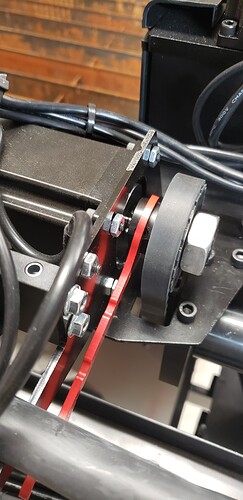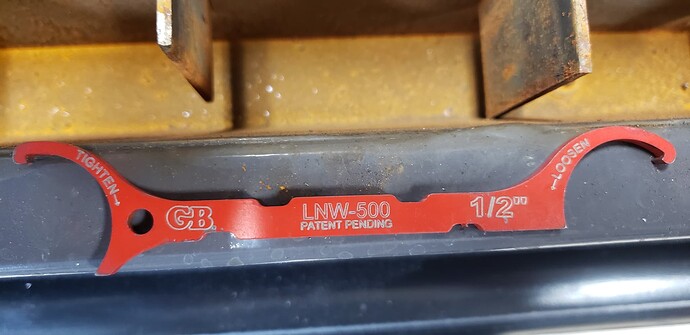Seeing several cut quality questions here and on the Langmuir Facebook support page that seem related to slipping couplers. The design of the XR is clever but it does make those adjustments a little tricky when fully assembled. The XR has three couplers (if I’m using that word correctly) for each ball screw thanks to the driven ball nut design. Once assembled, the access to the Y-axis couplers is pretty tight and a little blind. And even getting purchase on the drive shafts/hubs to do any tightening can be difficult. Would be great if Langmuir could put together a short how-to guide. Maybe fellow XR owners who have trailblazed could put something together?
My X-axis motor came with a loose nut that fastened the hub/belt drive coupler. The hub to motor shaft coupler was tight. Used this guy to hold the hub tight so I could tighten the nut. Would be nice to have a torque spec - went with goodentight.
This little spanner is part of a 3-piece set used to fasten conduit to an electrical panel. Very thin and just the ticket for holding the hub in place while tightening the X-axis nut.
Available at Lowe’s. A proper pin spanner would work too but a little hard to find in the smaller sizes and maybe not thin enough. And more expensive too.
My X-axis nut was loose too. Was surprised the pulley doesn’t have a keyway or set screw unless I missed it. Kinda weird it’s just relying on the nut pressure to hold it in place.
Right? Makes me wonder if Langmuir intended for this interface to be a sort of clutch mechanism? Dunno. But having it come loose means somebody needs a torque wrench.
The first batch of machines we were installing the nuts with a milwaukee impact gun. We’ve received a handful of reports from customers that these nuts arrived loose or were not tight enough to prevent slipping. We tested a few done assemblies that hadn’t shipped yet and the torque on the nuts varied from basically none to about 25 foot pounds. We summed this up to operator error, but at the end of the day its our responsibility for letting these leave our shop like this.
We switched from an impact gun to a torque wrench and now these nuts are torqued to about 50 lbft. Shouldn’t be an issue from here on.
As for why there is no key in the joint. The motor only outputs about 1.5-2 foot pounds of torque. The slip torque of the pulley with the nut properly tightened is probably 10x this at least. Therefore we felt there was limited benefit to add an additional part (key) and price increasing keyways to the pulley and hub.
There is a lot of precedent for using a non keyed joint like this. Many crankshaft pulleys these days (corvette, lots of fords) are not keyed to the crankshaft. Clamping force from the nut creates the necessary joint friction to transfer the torque.
Appreciate the reply Daniel. Any possibility of a maintenance guide from Langmuir? The Y-axis is going to be a little difficult for some if there is any slippage.

